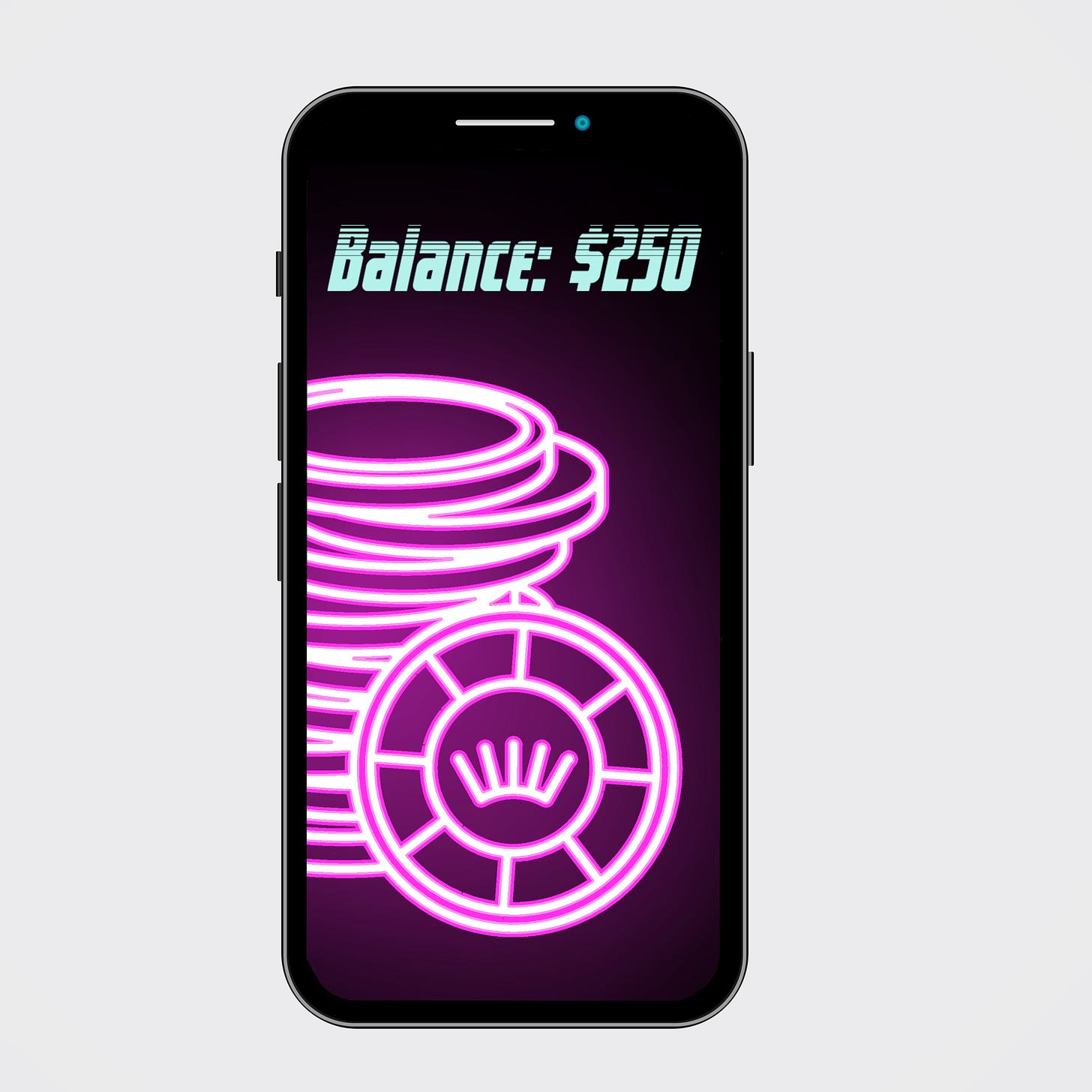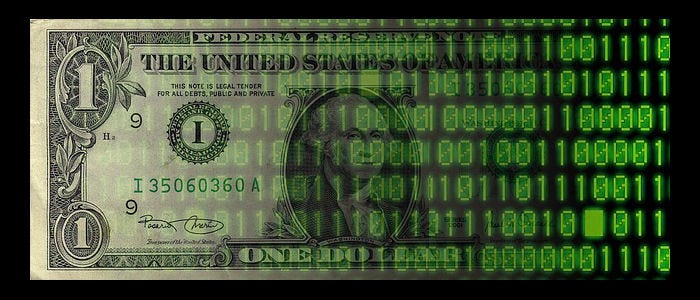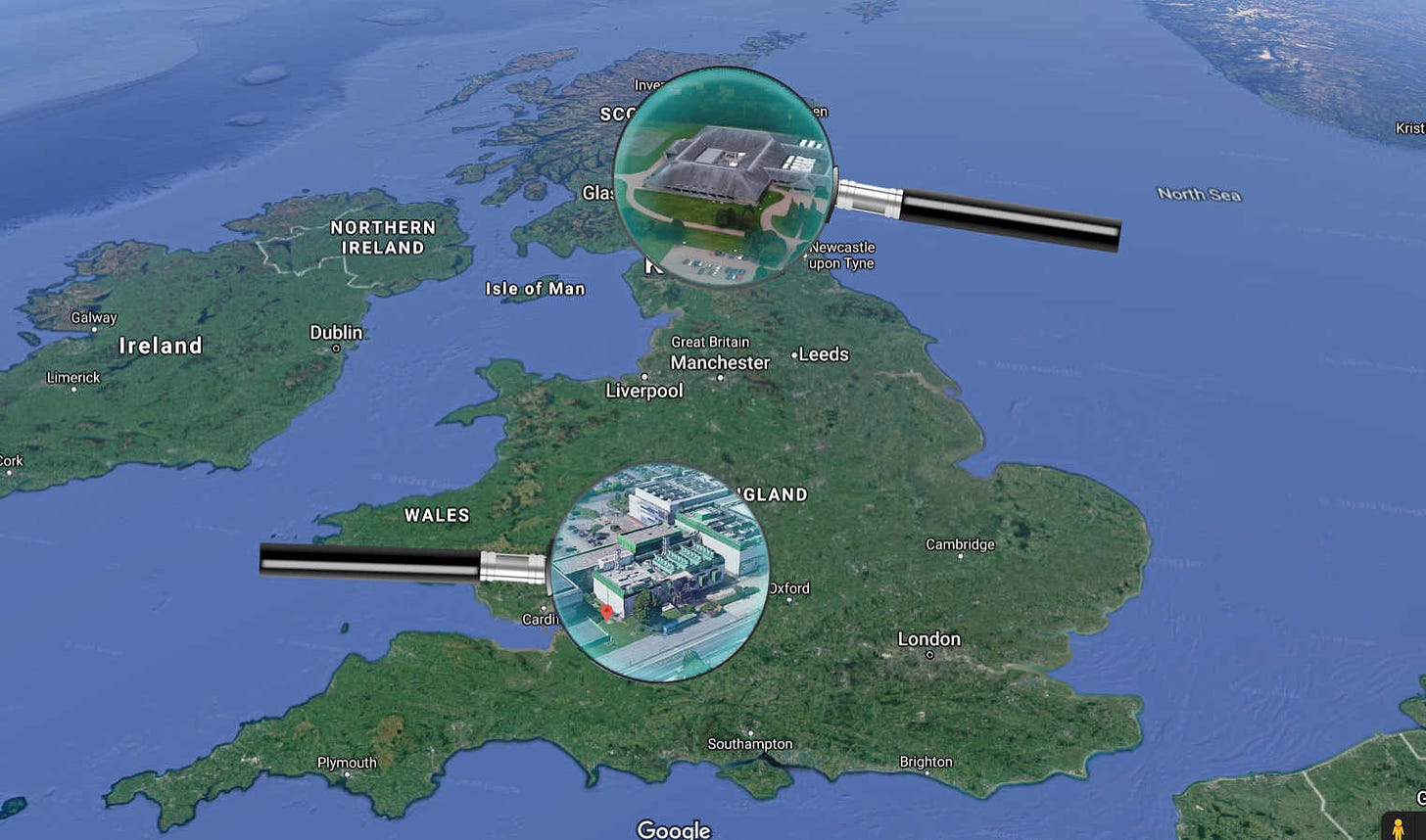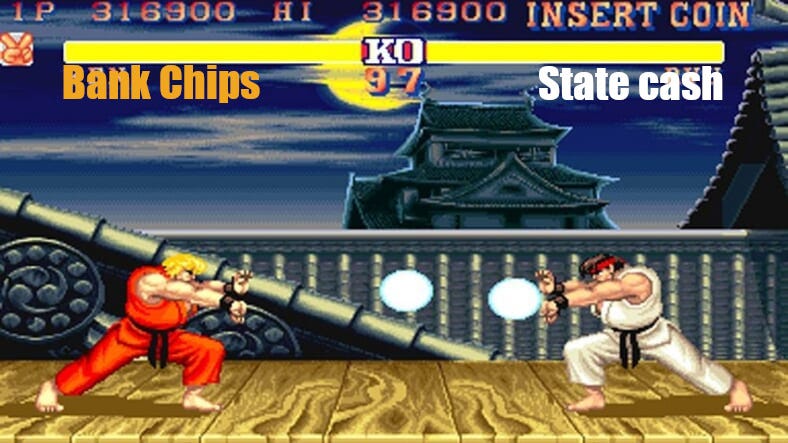

The Casino-Chip Society
source link: https://brettscott.substack.com/p/casino-chip-cashless-society
Go to the source link to view the article. You can view the picture content, updated content and better typesetting reading experience. If the link is broken, please click the button below to view the snapshot at that time.
The Casino-Chip Society
Why learning to see the layers of money will reveal the politics of 'cashless society', and much more
Many people believe that their national currency is a single currency, but that it appears in different forms. A person comparing a dollar bill with a dollar bank account balance may believe those are just different versions of the same thing, like comparing an acoustic guitar with an electric one, or a physical train ticket with a digital one. The same thing in a different form.
If you’re one of these people, you may be suffering from the dreaded OTOMI - the One-Type-Of-Money-Illusion - and it could be preventing you from understanding many crucial topics in monetary politics. For example, it could block your ability to understand the politics of cashless society (covered in my book Cloudmoney), because it may lead you to believe that digital money is just an ‘update’ to cash: the same thing in a more modern form.
Thanks for reading Altered States of Monetary Consciousness! Subscribe for free to receive new posts and support my work.
It has many other consequences. It could lead you to misrepresent, or misunderstand, ‘fractional reserve banking’. Many people suffering from the OTOMI believe that the state is the creator of money, so when told something like ‘banks create money’, they get flustered as their brain tries to process how one type of money is created by two different players, which can lead them to all kinds of conspiracy theories about banking. It is in fact true that banks do create money, but it’s very easy to misinterpret what this means if you’re carrying the OTOMI.
If you’re suffering from this affliction, take comfort in that you are not alone, and in the fact that it can be cured through a simple metaphor. Let’s visit the casino.
Note to readers: I’ve paused the paid version of this newsletter in 2022 due to the launch of my book, but it will be coming back online next year. Please do message me here if you’d like to be put on the waiting list.
Cash vs. Casino chips
Picture yourself walking into a casino with $100 in cash. You hand it over to the cashier, who puts it into a till and counts out a number of casino chips for you. Imagine them pushing those chips outwards across the counter, issuing them to you.
There are now two classes of thing here:
State-issued cash behind the counter, now owned by the casino
Casino-issued chips in your hand, now owned by you
It’s important to stress that you no longer own the cash. You own the chips, which are privately-issued legal promises - IOUs - that can be redeemed back for cash. If the casino tried to confiscate your chips without giving you any cash back, they would be stealing from you, and, similarly, if you tried to keep hold of your chips while grabbing cash back, you’d be stealing from them. It’s like that phrase “you can’t have your cake and eat it too”: you can’t simultaneously demand to own the cash, and the IOU that promises you cash. It’s one or the other.
This is confirmed by the fact that if you lose all your chips to another punter at the blackjack table, you can’t go back to the cashier to demand anything. The winner of the chips, by contrast, has increased their ability to demand cash back.
The punters know the relationship between the cash and the chips, and also find it very easy to make a distinction between them: The casino has the former. The punters have the latter. The former look like dollar bills. The latter look like coloured plastic disks. The former gets called ‘money’. The latter gets called ‘chips’. The first is a kind of ‘layer one’ base system, while the second is a ‘layer 2’ system. Two different classes, but linked together.
Digital Casino Chips
Let’s now imagine that the casino decided to digitize its operations. Rather than pushing physical chips to you across the counter when you give them cash, the cashier simply opens a database on the casino computer and credits an account under your name with digital chips. Perhaps you download an app where you can see that balance, or perhaps they give you a physical device, like a wearable wristband that you touch upon a terminal when you wish to lay down digital chips on a table. There are different ways to technically implement such a system, but the digital chip is a Layer 2 IOU just like a physical casino chip would be, and whoever has these at the end of the night can take them back to the cashier to redeem for Layer 1 cash.
Money in your bank account is ‘digital chips’
The casino model I describe above is actually the best starting point for understanding your bank account. Here’s why.
Many people get ensnared in a series of linguistic traps when they talk about bank accounts. A person ‘deposits cash into a bank’, and then is told that they have a ‘bank deposit’ which represents ‘money in their account’. It makes us think that a bank deposit is cash ‘inside’ our account, but this is very wrong.
To rewire this understanding, just think of the casino model. When I approach a bank with cash and hand it over to them, they - like a casino - take ownership of it and issue out ‘digital chips’ to me, which are recorded in my account. When you see units in your bank account, you are not looking at ‘money I put inside the bank’. You’re really looking at ‘second-layer digital chips issued out to me’. The term ‘bank deposit’ is just a confusing and unhelpful way of describing ‘bank-issued digital casino chips’.
This means that, on a day-to-day basis, we (mostly) use two separate types of money, with different issuers:
Layer 1 state-issued physical cash
Layer 2 bank-issued digital ‘chips’, that promise access to the first layer
Both, however, get given the same name. In the UK, for example, both the state-issued cash and bank-issued chips get called ‘pounds’, and are both classed as money. They also carry the same symbol, and because the digital chips have no physical body, newspapers and photojournalists often just represent them using state cash imagery (to truly show UK ‘digital money’, however, you’d have to show images of units recorded in datacentres controlled by the likes of Barclays Bank and RBS).
The net effect is that people seldom distinguish between these forms, collapsing them into the OTOMI. Make no mistake though: a person looking at ‘dollars’ in their Chase bank account is looking a Chase digital chips, whereas someone looking at units in their Wells Fargo account is seeing Wells Fargo chips. Given that there are over 4400 different US banks issuing these chips, the Layer 2 US dollar is actually at least 4400 different currencies with the same name.
One of the factors that obscures this is the fact that banks run big payments networks between themselves to link their separate digital chip systems together, such that a holder of Wells Fargo chips could transfer, via a number of steps, to a holder of Chase chips, giving rise to a feeling of a seamless transfer of generic ‘dollars’. This only works because banks move state money reserves between each other in the background (somewhat like casinos who’ve agreed to transfer cash to each other if their punters try pass chips from one establishment to another).
But banks have a superpower that casinos do not
I use this metaphor of casino chips to show the distinction between Layer 1 and Layer 2 systems, but we must be careful to not push the metaphor too far. Probably the biggest difference between banks and casinos is that banks are able to issue out far more digital chips than they have in a state money ‘behind the counter’. This is because of a process called credit creation of money, or ‘bank creation of money’ (sometimes called ‘fractional reserve banking’, although this is a more archaic phrase that sometimes carries the dreaded OTOMI with it).
This is a technical topic, but the short version is that banks not only issue out new digital chips to people who hand over cash to them, but also to people who ask for loans. Imagine a person arriving a casino with no money but requesting chips nevertheless - this is pretty much what happens when someone approaches a bank and asks for a loan. They’re not asking to be given cash that’s stored there. They’re asking the bank to issue new digital chipsto them.
Remember that a chip is a liability to its issuer. Whoever ends up with those chips can come back to demand cash, so - in the case of a casino - it’s not in their interest to randomly issue huge numbers of chips to customers who don’t actually deposit anything. These chip liabilities put them at risk, so they only issue them if they get something in exchange.
It’s the same with banks, but they issue digital chips in two different situations for two different things:
Digital chips for depositors: they issue Layer 2 chips to normal depositors in exchange for Layer 1 cash reserves
Digital chips for borrowers: they issue Layer 2 chips to borrowers, in exchange for a loan agreement in which the customer promises to return a larger amount of Layer 1 money to them in future than what the chips promise to them now (in a sense, the bank ‘buys’ a higher-value long-term promise by issuing lower-value short-term promises, but exposes itself to risk in the process).
So, unlike casinos, where the cash and chips stay in sync, with banks the two forms diverge: the Layer 2 digital chips that they issue expand far past the Layer 1 government money held by the bank, as the bank extracts loan agreements from that second class of customer. This is why the money supply (of second layer chips) expands as banks make new loans, and contracts as those loans get paid back.
Why this matters for understanding ‘cashless society’
If the technicalities above are a bit tricky, don’t worry. What matters is to understand that we live with at least two different types of money, the first issued by the state, and the second issued by the banking sector.
As mentioned, people who suffer from the OTOMI often believe that the move towards a cashless society is a process by which the One-Type-Of-Money simply upgrades to a more advanced version of itself. In reality, the move towards cashless society is the result of a battle between two different parts of a hybrid monetary system. It’s the situation in which Layer 1 state-issued physical cash is overrun by Layer 2 bank-issued digital chips.
In reality, a cashless society is a type of enclosure, in which the only form of money in society becomes digital bank chips (a bit like being stuck in a network of casinos where you can no longer exit). I write a lot about the consequences of this elsewhere, but the important point to take away is that digital bank money is not an ‘upgrade’ to cash, any more than a casino chip is.
‘Cashless society’ vs. ‘bank-chip society’
The phrase ‘cashless society’ annoys the hell out of me because it references something that is not present - Layer 1 cash - rather than something that is present - Layer 2 digital bank chips. It’s been a big frustration of mine for a long time, as my recent tweet shows:
Perhaps the only phrase that captures what’s present is something like the Casino-Chip Society, or maybe the Bank-Chip Society, but you can see why the digital payments industry wouldn’t want such a reframing to take place. They want people to think that digital money is basically just an upgrade to cash, so it helps to not draw attention to the chip-like nature of digital units. Confidence in the Layer 2 system is psychologically dependent upon people believing that those chips are essentially equivalent to public money. And, much like a casino chip might start to feel suspicious if you were no longer able to redeem it, people might start to feel suspicious if they saw their digital balances as becoming increasingly unredeemable.
The irony is that those chips derive much of their power from their association to the state money system, all while their issuers try to compete with and undermine the state money system. It’s a bit like a situation in which Uber becomes the only means of transport, while the company demands that the state maintains the public road infrastructure. The banking sector essentially wants the central bank to keep managing public confidence in money, while allowing the industry to erode access to public cash.
Chips-for-chips
Our monetary system doesn’t just stop at the second layer though. Imagine taking a casino chip and handing it to the operator of a gaming arcade or theme park in exchange for a token that can be used within their premises. You’re using a Layer 2 chip to get a Layer 3 chip.
There are thousands of Layer 3 systems in our monetary system. For example, PayPal will accept Layer 2 bank chips from you, put those into their own bank account, and then credit you with Layer 3 units in your PayPal account. You can then move those to other PayPal customers (or request to redeem them back).
Most Layer 3 systems don’t (at least officially) have a ‘fractional reserve’ element. They’re a normally fully backed, which means every Layer 3 chip is supposed to be matched by a Layer 2 chip somewhere else in the system. If you see 100 dollar units in your PayPal account, you’re supposed to assume that PayPal is holding 100 dollar chips in its bank account somewhere (or at least something that can be easily sold for dollars, like US government bonds).
Perhaps the most talked-about new contender in the Layer 3 category are backed ‘stablecoins’ like those issued by companies like Circle. Circle will have normal Layer 2 chips in a bank account, and will then issue Layer 3 chips that can be moved around within a blockchain network architecture, rather than a centralised architecture of the kind PayPal would use.
PayPal and Circle are big players, but there are many tiny issuers of Layer 3 money. In the US, this could include pretty much every business that issues dollar-denominated vouchers and gift cards, or gaming platforms that issue online game currencies. If you have an account with any non-bank institution that also has a money balance associated with it (for example, a Euro balance in stockmarket account, a pound balance in a UK online horse-betting platform, or dollar units in your Uber Cash account), they’re probably going to be Layer 3 chips. Some of these get rebranded with a new name - such as ‘Amazon Coin’ - in which case they get called ‘virtual currencies’, but in essence they’re just Layer 3 chips.
OTOMOI-TF to TLOMMI-TF!
As mentioned, many people live with the idea that there is one-type-of-money (OTOM), with one issuer (OI), in two forms (TF), physical and digital. Let’s call that OTOMOI-TF. What we’ve seen, though, is that a national currency like the US dollar is not a single currency. It’s an ecosystem consisting of:
The base US dollar, issued by two players (the Fed and the Treasury)
Layer 2 US dollars, issued by over 4400 banks
Layer 3 US dollars, issued by a constellation of thousands of private players, from small town theme park operators to colossal players like Facebook
So what we have is (at least) three layers of money (TLOM), with multiple issuers (MI), in two primary forms (TF), physical and digital. This is TLOMMI-TF. By using this framework we can build a much more fine-grained analysis of the politics of money, because we can cut monetary systems into conceptual slices:
TLOM: We can analyse the interaction between the three layers
MI: We can analyse the dynamics of, and relationships between, the issuers - central banks, state treasuries, commercial banks, Venmo, Amazon, local country fair, online gambling company etc.
TF: We can analyse the differences that occur when the different issuers issue their different layer tokens in digital or physical form
10 monetary topics that this can help us understand
With these conceptual slices in place, we’re in a much better positions to understand current battles going on in the monetary system. For example:
Cashless society: Probably the biggest meta-battle going on right now is between Layer 1 state money issued by central banks and treasuries in physical form and Layer 2 digital bank chips. The ‘cashless society’ debate is really about whether the Layer 2 players should take full control, or whether a balance of power needs to be maintained by protecting the cash system. I’m a big advocate for defending the balance of power.
Central bank digital currency (CBDC): The banking sector has been attacking the cash system for decades, but confidence in their Layer 2 chips depends on the public being able to redeem them for state money. This is now inspiring a new debate about whether there needs to be a new Layer 1 money issued by central banks in digital form, called CBDC. In reality, Layer 1 CBDC has existed for decades, but it’s traditionally called ‘reserves’ and is only accessible to banks who use it between themselves. The CBDC debate is really about whether access to digital state money should be extended to all of us.
Stablecoins: I already mentioned these above, but stablecoins are issued by a range of different players and offer, like PayPal, an alternative to holding Layer 2 banking sector chips, while (hypothetically at least) being better at preserving some level of anonymity.
The sandwich: banks control the Layer 2 system, but see a future in which they might end up sandwiched by competition from a hypothetical Layer 1 CBDC and Layer 3 stablecoin systems (which admittedly plug into them). This is why banks are currently lobbying against CBDC to water it down (e.g. demanding limits upon its use), while demanding that stablecoins be regulated in the same way that banks are.
Monetary sovereignty in an age of unregulated Layer 3 dollars: If you’re the governor of a small central bank in a country that’s low on the geopolitical pecking order, you may face the prospect of your citizens getting access to digital dollar stablecoins issued by the likes of Facebook. This may undermine your already tenuous monetary sovereignty, and raise the prospect of your country become a vassal within a Layer 3 corporate-issued dollar system. In this context, you may feel some pressure to push a local Layer 1 CBDC to compete with that, even if it upsets your local banking sector.
Layer 1 cold wars: Alternatively, perhaps China sees an opportunity to erode dollar dominance in weaker countries, pushing out a CBDC yuan that can be used by my family in Zimbabwe. This could feed back to players like the US Federal Reserve, who may feel some pressure - imaginary or real - to compete in a kind of CBDC arms race, even if the powerful US banking sector hates that idea.
Layer 1 alternatives to CBDC: my friend Rohan Grey has been at the forefront of proposing a new type of privacy-preserving Layer 1 digital money that could be issued by the US Treasury instead the Federal Reserve, via the E-Cash Act proposal. It plays on the political differences between the two different issuers of Layer 1 money.
More generally, taking the layered approach helps to explore perennial topics like:
Eurodollars: chips for US dollars need not only be issued by US entities. For example, a European bank, which may or may not hold Layer 2 dollar chips at a US bank, might issue dollar chips to European customers. This is the so-called ‘Eurodollar’ market.
Deposit insurance: many governments guarantee Layer 2 digital bank chips up to a certain amount, making them conceptually as safe as Layer 1 state money. This leads to obscure debates about whether those Layer 2 chips truly can be considered as privately-issued, or whether they are better thought of as a form of state money that has had its issuance delegated to the banking sector. To me, a state-insured bank-issued chip is not the same as state-issued cash, especially given that the former isn’t considered legal tender in most countries, whereas the latter is.
The shadowbanking sector: I highlighted three layers of money, but - much like it’s tricky to tell where the outermost layers of the atmosphere end - it’s tricky to demarcate an exact final layer to the monetary system. US dollar bonds, for example, are promises-for-future-US-dollars issued out by the US government, but they can be exchanged in a ‘moneylike’ fashion. There’s also the entire shadowbanking sector, in which short-term debt instruments, repos, money market fund units and so on, are passed around. A person interested in monetary politics must also wade into the murky depths of these Layer 4 type systems
Why this matters for understanding ‘fractional reserve’
Many people still suffer from the belief that banks take money that was put inside them by depositors, and then lend that out to borrowers, but this is classic OTOMI-style thinking. The person is imagining Layer 1 state money entering a bank, and then that same Layer 1 money being sent off by that bank as a loan to someone else. In this framing, banks are a kind of shadowy intermediary for state money, deceptively telling us that our money is there when it isn’t.
The reality, as described earlier, is that banks are not intermediaries for state money. They are money issuers in their own right, issuing chips that are out of sync with their reserves in order to harvest loan assets.
The old OTOM conception of fractional reserve banking can be summarised as ‘banks keep a fraction of the Layer 1 money that is put into them, and then lend the rest out’. The much better TLOM conception, by contrast, is ‘the Layer 1 state money held by banks is a fraction of the size of the Layer 2 chips they issue out’.
The outwardness of digital money, and money as a liability
I’ve worked with monetary reform groups in the past who do try raise public awareness of the fact that ‘banks issue money’, but one of the first mistakes people make when hearing this is to imagine that the banks are issuing money to themselves (a bit like a casino giving chips to itself). In reality, banks are issuing money outwards to people like us, and that’s something that puts banks at risk.
The casino chip metaphor is great for conveying this ‘outwardness’ of digital money issuance. It also helps us to see that there are consequences to excessive money issuance for the bank: the bank is issuing something that it experiences as a liability, not as an asset, and it can backfire on them if they do that excessively. If it were to, for example, just conjure up $40 billion in new chips without having a plan about where to get reserves to manage possible chips redemptions, they can bankrupt themselves.
The thickness of thin air
When describing the processes above, it’s common for monetary reformers to say banks create money ‘out of thin air’, or ‘out of nothing’. Sometimes this has a subtext, which is the idea that money should be something that is dug out of the ground like a commodity, hard and certain. I’m a big critic of many aspects of bank power in society, but the phrase ‘thin air’ is often supposed to generate a kind of moral panic by suggesting something flimsy, ephemeral, fake or unreal, and that seldom helps our understanding of how these systems work.
I can issue a promise to someone by speaking it out, or writing it down, and in that sense I’m creating it out of ‘nothing’, but that doesn’t mean it has no power or reality. Almost all Layer 2 and 3 systems - from bank chips to gift cards handed out by Wallmart to units issued by an online betting platform are technically created from the act of a company making a legally binding promise that they can get sued for if they break. Thinking of these different layers of money as enforceable ‘chips’ within a legal system helps to highlight that ‘thin air’ is thicker than we may think.
Technical questions for money geeks
Once you have grasped this layering approach, you can start to play more freely with how the relationship between the different classes might work, asking productive questions like:
Do banks try maintain a fixed ratio between their Layer 1 reserves and the newly issued Layer 2 chips, or is the linkage a lot more loose? Do the two forms end up being semi-independent of each other? Do they first try get reserves and then issue chips after that, or is it the other way around? What agreements do they have with the central bank if they f*ck up in this process? What constrains their issuance of chips? How do the different official regulatory ratios (capital adequacy etc.) affect this? What is the relationship between central bank monetary policy and bank creation of money? Is it really central bank money issuance that may cause inflation, or is it bank chip issuance?
These are just some of the questions, and hopefully we can delve into those in future. I’ll be back soon with more on how to reframe ‘cashless society’, but in the mean time please do play with this framework I’ve laid out, and please do add further examples and questions in the comments below. I hope you’ve found this useful.
Thanks for reading Altered States of Monetary Consciousness! Subscribe for free to receive new posts and support my work.
Recommend
About Joyk
Aggregate valuable and interesting links.
Joyk means Joy of geeK





